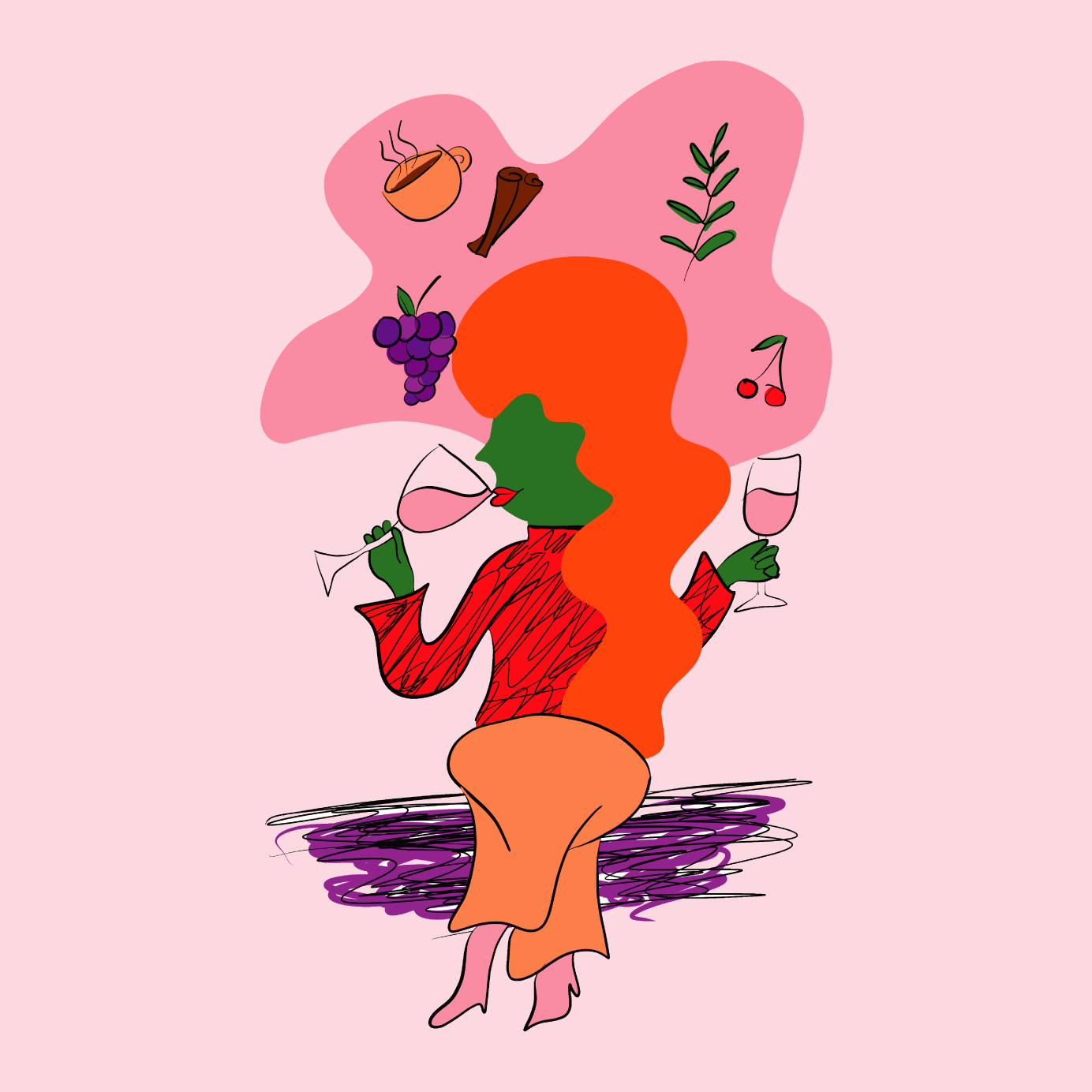Among the wine industry’s countless affectations (audible sipping, francophilia) lie tasting notes. Widely utilized and often misunderstood, wine tasting notes range from generally accessible culinary descriptors like “baking spices,” to such strange sentence constructions as referring to scent by saying “on the nose.”
Retailers, sommeliers, and others in the industry regularly use words like “elegant” and “structured,” not to mention “tennis ball” and “basement.” Presumably, they do so in hopes of empowering wine drinkers with the language to talk about their favorite bottles.
But convoluted tasting notes inevitably alienate at least as many prospective consumers as they entice. It begs the question: Is it time to change the way we talk about wine?
*
The main role of wine critics is to analyze and judge wines so that the rest of us can get a sense of what bottles we might want to buy and taste. And yet the language wine critics use is often comically opaque.
In a review of a bottle of 1999 Château Canon, world-famous wine critic Robert Parker wrote, “This medium dark ruby-colored effort reveals soft, berry flavors with steely/mineral-like notes in the background. Some of the vineyard’s pedigree comes through, but this uninspiring, medium-bodied wine possesses little depth or length.”
While experienced tasters might understand what words like “depth” and “length” mean, this is some heavy prose. Reviews like this only serve high-end consumers, or those who already have a decent amount of wine tasting experience (and active imaginations).
Parker also popularized the 100-point rating scale which, despite its myriad shortcomings, does undoubtedly communicate quality in a way that every consumer can understand.
And yet no number can accurately reflect what a wine tastes like.
Lisa Perrotti-Brown, editor-in-chief of Robert Parker’s Wine Advocate, writes, “Tasting notes are an important companion to scores, because they describe the wine’s style, personality, and potential. You could certainly do worse than buying a 95-point or even a 100-point wine, but how do you know you’re going to like it if you don’t know what it’s like?”
Thus, tasting notes persist among critics from Eric Asimov to Jancis Robinson to James Suckling. (Parker retired in 2016.)
*
William Thomas is a U.K.-based food and wine copywriter with years of experience writing wine label notes for large-scale retailers, as well as small importers. Thomas believes that label tasting notes are useful because they help consumers identify the style of wine they’re looking for. “Everyone has a certain idea of what they want,” he says, “but they’re also looking for some inspiration.”
When writing label notes for supermarkets, Thomas works with a variety of wines that retail over a range of different price points. “I try and be as honest as possible about the product, and try to match [the tasting notes] to the customer,” he says.
For entry-level wines, Thomas uses fewer, and more generic terms, like “fruity” and “herbal.” He believes that consumers buying wines at this range are less likely to have a wealth of wine-tasting experience, and he doesn’t want to intimidate them.
But for premium wines, he uses more specific, in-depth tasting notes. Customers comfortable spending more money on a bottle likely have more tasting experience, he says. By listing more flavor and aroma descriptors, he also helps justify a wine’s elevated price. Spend more on a bottle, and there will be more to smell and taste. He typically includes a list of specific fruits and herbs on top-tier wine bottles, as well as references to what’s happening in the vineyard and aging practices.
While wine label notes are well intentioned, the assumption that a drinker’s budget represents their wine tasting experience does present some classist concerns. Wine novices might be willing to spend a lot of money, after all, but in-depth tasting notes do nothing to help them navigate lofty price points. Supermarkets and winemakers are right to list the many merits of their wines, but would be wise to do so using language that doesn’t discriminate.

*
Food recommendations are also useful, Thomas says, because they’re relatable and actionable. Someone shopping in a supermarket might already know what they’re going to eat that night, and might make their wine purchase accordingly.
Unfortunately, pairing recommendations are not an indication of quality. In fact, they may denote something else entirely.
Mark Thornton is a postdoctoral research associate at Princeton University’s department of psychology. For a 2015 study on the language used on wine labels, Thornton pulled a sample of 75,000 wines sold on Wine.com and compared their label tasting notes to the ratings assigned by wine critics and Wine.com users.
In his analysis of the study, Thornton notes an interesting conclusion: “The common denominator of the back labels of bad wines appears to be mentioning ‘pasta.’ Pasta shows up in the bad clouds for both red and white wines in the consumer rating analysis, and for reds in the professional rating analysis.”
This could be because there are fewer merits for the winemaker to list, Thornton says. Or, the wine might have some off notes, and so producers recommend drinking it alongside foods with flavors strong enough to conceal its flaws.
Thornton also believes that complex tasting terms like “length” and “structure” are among the most alienating for novice tasters. But learning how these words apply to wine could not only make drinkers feel more at ease describing what’s in a glass, it could also allow them to have a deeper appreciation of wine, Thornton says.
His theory is based on psychological research that suggests that human perception of different emotions increases with having the vocabulary to describe them. Armed with greater vocabulary, wine tasters could experience more nuanced aspects of the drink, Thornton suggests.
“It’s really important to have the words to hang our concepts on,” he says.
*
The final form of wine tasting notes includes technical descriptors used by wine education institutes like the Wine and Spirits Education Trust (WSET). Students enrolling in WSET courses familiarize themselves with the Systematic Approach to Tasting (SAT), by which they analyze every aspect of wine, including flavors and quality. To describe tannins, for example, WSET students use terms like “low,” “high,” or “medium plus.”
Dave Rudman is the USA business development director for WSET. He says that, above all, this form of tasting and describing wine benefits industry professionals the most.
A standardized method of describing wines ensures a concise understanding of a product during a tasting, he says. Plus, it proves invaluable when sampling a vast portfolio of wines side by side.
During industry tastings, wine professionals can use the SAT to quickly evaluate wines and write concise notes they can use to paint an accurate picture of what they’ve tasted further down the line.
“For a professional, you can’t rely on the tasting notes that are going to be on a label or tech sheet,” Rudman says. “You have to have an approach to tasting wines, such that you can encounter wines and put them into a global context — not just against other wines made from the same varietal, or other wines made in the same region, but in an all-encompassing context.”
It is the role of sommeliers and retail staff to then deliver the “Cliff Notes” version of these tasting notes to consumers, Rudman says, picking out the most pertinent, character-defining aspects of a wine, and conveying them using language that all drinkers can understand.
A good sommelier does this successfully and at the same time is able to interpret a diner’s taste from their own imprecise, and often technically inaccurate, descriptors.
Those who fail, however, do so because they ignore the fact there was a time in which they didn’t understand words like “structured” and “depth.” Alternatively, they might be using intentionally floral language to justify a wine’s lofty price tag, or to close a sale.
Sadly, neither of these actions help cure wine’s elitist reputation.
*
“A little bit of knowledge goes a long way in wine,” Thomas says. “The more you know about your own taste, the more you can get from wine.”
At all levels, often-maligned wine tasting notes serve a valid purpose. Critics continue to use words like “structure” to describe a wine’s combination of acidity and tannins because they are the most accurate and succinct terms. This is also what makes the technical tasting notes of the SAT so useful.
Yes, these descriptors require tasting experience, but they serve a valid purpose for their intended audience. Growing that audience, however, will require describing wines in clearer language that everyone feels comfortable with.
If wine industry professionals truly want to make wine more open and accessible — besides providing free wine education for all— sommeliers and critics should carefully consider when to use technical language. In wine, as in most things, it’s better to keep things simple.
